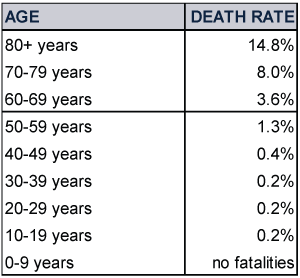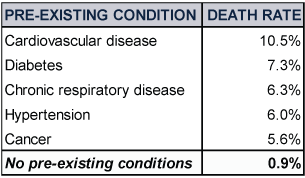Personal Wealth Management / Market Analysis
Coronavirus: Seeing Through the Fog of Fear
What we learned in our review of hundreds of coronavirus articles.
Considering coronavirus coverage dominates nearly every news website, broadcast, blog, social media outlet and publication, we think it is clear information—and, sadly, misinformation—about it abounds. That slew of coverage is seemingly fanning fear, which makes focusing on facts currently known about the outbreak much more urgent, in our view. Now, we aren’t physicians or scientists that research contagious diseases. Neither of us studied medicine. We claim no real or advanced knowledge of such matters. But part of what we do is analyse media—our team covers dozens of outlets daily from around the world. Collectively, we have read hundreds of articles on the subject—and found some significant overlap across various experts about what they say is accurate and what isn’t. Whilst there are still some significant unknowns about the outbreak, we thought rounding up our findings may help readers. Now, of course, all this could change—and some statistics surely will—but we hope to provide you as good a basis for seeing this as possible now, given extant fear over the issue. Without further ado, here we go.
How Many People Have the Coronavirus?
Most outlets we have reviewed cite the total number of identified cases in response to that question. As of 11 March, Johns Hopkins University’s dashboard (which you can view here) cites 121,564 coronavirus diagnoses. However, there are a few caveats to this. One, that doesn’t deduct the number of patients who have recovered or, tragically, died. The same resource counts 66,239 patients as having recovered from the virus and 4,373 having died. Hence, these data show 50,952 persons currently known to have coronavirus globally.
Of course, these numbers are likely understated. Limited testing worldwide means officials only identify those patients with the most severe symptoms. When Elisabeth got swine flu (the H1N1 influenza virus) during 2009’s pandemic, she was not part of the official tally because she stayed in bed and had fever dreams instead of checking in at a clinic. That the coronavirus is likely more widespread than data suggest may seem frightening, but it brings us to another critical point to consider: The coronavirus death rate is likely overstated—potentially by a lot.
How Deadly Is the Coronavirus?
Interviews with professionals we covered nearly uniformly agree on this point. If you use basic math and simply divide the number of deaths by the total number of identified cases, you may think the death rate is around 3.6%. But the trouble with this is, again, identification. As Tom Frieden, former director of the US Centers for Disease Control (CDC), put it, that rate “is certainly an overestimate.” The reason: Limited testing means many mild cases went unidentified. At a 6 March panel discussion in Washington DC, Johns Hopkins’ Dr. Tom Inglesby stated that roughly 80% of known cases were mild. So mild that patients recovered with no hospitalisation or medical intervention. (Some 15% did need hospitalisation and 5% critical attention, according to him.) Many others likely didn’t even know they had it.
This means we don’t have the right denominator to calculate the death rate. In South Korea, where testing has been more aggressive, Dr. Inglesby noted the death rate was 0.6%. Frieden told Bloomberg reporters he expected the death rate to eventually hover around 1%, after more widespread testing causes the number of identified cases to increase. Now, that is speculation to an extent, but it is educated speculation that seems logical given the backdrop. That puts the death rate higher than influenza, which the CDC estimates killed an average 0.14% of Americans contracting it from the 2010/2011 flu season through 2017/2018.[i] But it is far lower than mortality rates tied to 2003’s Severe Acute Respiratory Syndrome and other similar outbreaks.
Who Is Most at Risk of a Severe Form of the Coronavirus Illness?
Older people—and, particularly, those with pre-existing health conditions. Again, these data are likely overstated, but there are some findings we think are worth noting. World Health Organization (WHO) data show those over age 60 are at an elevated risk, with those over 80 particularly vulnerable. The table below is as of 29 February, but it contains the latest available data, and the general gist likely still holds.
Exhibit 1: Global Coronavirus Fatality Rate by Age

Source: World Health Organization, as of 29/2/2020.
Moreover, many who have died, especially the younger victims, had major pre-existing conditions—another point global data show.
Exhibit 2: Pre-Existing Conditions Exacerbate Death Rate

Source: World Health Organization, as of 29/2/2020.
Dr. Lisa Lockerd Maragakis, also of Johns Hopkins, echoed this point, noting that high-risk groups cluster amongst the elderly—which is normal for virtually any illness. As she put it, this “happens every year with influenza.” So, this is a sign older readers should take caution. If you feel ill—fever, cough, and shortness of breath are common symptoms, although gastrointestinal issues can be too—take action. Those particularly at risk may wish to consider limiting in-person social interaction.
Because the Number of Cases Seems to Increase Exponentially, the Coronavirus Must Be Highly Contagious, Right?
This viewpoint has gained popularity thanks to the likes of Microsoft founder and philanthropist Bill Gates, who said the virus may be the “once in a century pathogen we’ve been worried about.” But how does the coronavirus’s contagion compare with other infectious diseases?
Researchers measure contagion with a statistic called the reproduction number, denoted as “R0.” It estimates the number of people each patient is likely to infect. Bloomberg rounded up R0 estimates for the coronavirus and other infectious diseases from the WHO and CDC and found that, whilst the coronavirus’s R0 of 2.8 makes it more contagious than seasonal influenza (1.3) or Ebola (1.9), it is much less contagious than smallpox (4.8) or the measles (15.0). A separate New York Times analysis estimates it is also far less contagious than chickenpox.
Yet even these comparisons may overstate the transmission risk. As WHO Director-General Tedros Adhanom Ghebreyesus explained on 2 March: “We don’t even talk about containment [measures aimed at restricting the spread of an illness] for seasonal flu – it’s just not possible. But it is possible for Covid-19.” He elaborated: “We have never seen before a respiratory pathogen that’s capable of community transmission but at the same time which can also be contained with the right measures. If this was an influenza epidemic, we would have expected to see widespread community transmission across the globe by now and efforts to slow it down or contain it would not be feasible.” WHO officials have also observed that the coronavirus appears to be much less contagious than influenza before symptoms appear.
Don’t the Statistics Show the Coronavirus Is More of a Threat Than Seasonal Influenza.
This answer depends on how you define “threat” and which data you cite. As shown above, the documented R0 and fatality rate are higher for the coronavirus than influenza. Its fatality rate is far below 1% of infected patients, compared to 3.6% for the coronavirus. We deconstructed the latter above. But even if you take it at face value, it doesn’t mean the coronavirus is worse than your typical seasonal influenza thus far.
The WHO estimates that of the tens of millions of people who contract influenza globally each year, there are between 3 and 5 million severe cases, with 250,000 – 500,000 fatalities. At last count, as mentioned above, the number of confirmed coronavirus cases is 121,564, with 4,373 deaths. That is between 0.9% and 1.7% of the amount of annual influenza casualties.
What About the Economy?
To turn to something much more in our wheelhouse: the virus’s economic impact. It is too soon to know exactly how the coronavirus will impact economic growth, in our view. There will almost certainly be some kind of hit, with most forecasts we have seen from both private-sector entities and official organisations like the International Monetary Fund suggesting slowing growth. But, and this is key, we think the hit looks to be temporary. Already, various purchasing managers’ indexes hint at inventories falling whilst order backlogs rise—fuel for a rebound in growth, in our experience. In China, there are already signs of recovery taking root. One Chinese online travel agency noted hotel bookings soared 40% in the week ending 1 March from the prior, whilst flight demand skyrocketed. In a hard-to-refute sign the country is getting back to work, nitrogen dioxide pollution is back. The gas, a byproduct of utility output and factory emissions, largely vanished amidst the twin impact of China’s Lunar New Year holiday and coronavirus-related shutdowns. American satellites photographed this recently. We aren’t cheering pollution, but the return of it seems to us like a pretty tangible sign of a rebound. Of course, there are many other pollutants—and China’s economy is mostly services these days, not factories.[ii] But it still seems relevant to note, in our view.
Because the coronavirus outbreak is new, still ongoing and its eventual end is unknown, fear is running high. We hope to cut through some of that emotion by sharing the findings of our broad-based survey of media in one consolidated place.
[i] Source: CDC, as of 6/3/2020. Data for 2017/2018 season are preliminary estimates. https://www.cdc.gov/flu/about/burden/index.html
[ii] Statement is based on the sector breakdown of Chinese gross domestic product, a government-produced measure of economic output. According to World Bank data, services is 52.2% of Chinese output. https://data.worldbank.org/indicator/NV.SRV.TOTL.ZS?locations=CN
Get a weekly roundup of our market insights.
Sign up for our weekly e-mail newsletter.

See Our Investment Guides
The world of investing can seem like a giant maze. Fisher Investments UK has developed several informational and educational guides tackling a variety of investing topics.




